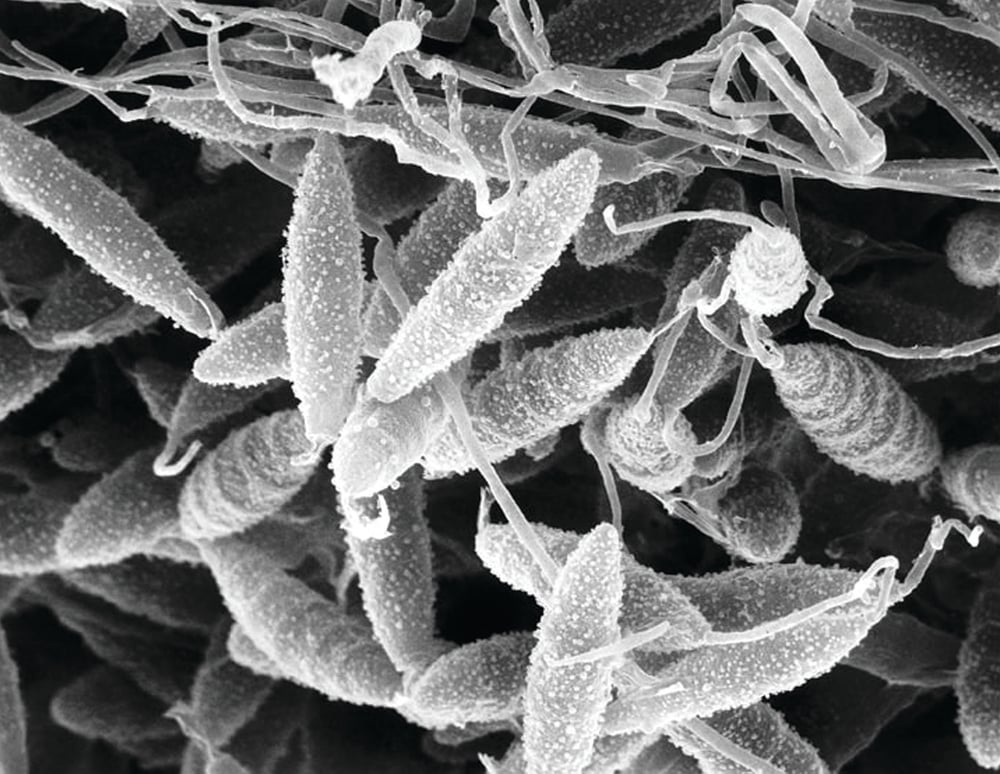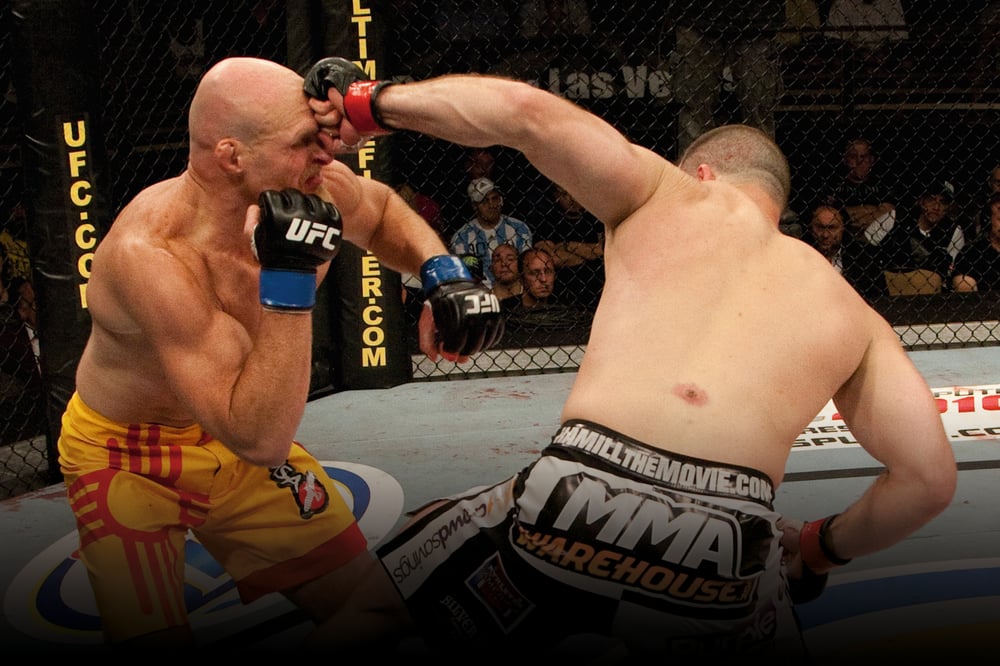
Issue 067
November 2010
Matt Hamill's staph lesion (pictured here) brought one of MMA's less attractive hangers-on into the open. Skin infections such as staph picked up in the gym can stop you training – or ruin an MMA career.
When fighters fail to protect their skin, they don’t just risk getting a pimple or an uncomfortable rash, they’re risking time away from training, title shots and earning money. Education is the best weapon against the most common skin diseases such as herpes, staph and scabies. So pay attention and take notes.
Cleanliness
“The number one transmitter of disease is a lack of good personal hygiene,” says Dr Meghan O’Brien from her private dermatology clinic in Manhattan. “People stick their fingers in their nose, they stick their fingers in their butts. You need to be disciplined about your hygiene, because you’ve no guarantees anyone else will be.”
Preparing to combat a skin disease is similar to training for an opponent; good information, a smart game plan and solid execution are the keys to success.
The first item in your gym bag should be a bottle of antibacterial soap, followed by a fresh towel and a clean razor. For gyms or training situations that seem more threatening you should pick up a bottle of benzoyl peroxide wash, which is proven to eliminate more bacteria than any other over-the-counter soap. Bringing your own amenities guarantees that you never have to share, which significantly reduces risk. “No matter how fast you need to get out of the house, you should always bring a fresh towel and make certain no one else borrows it,” says Dr O’Brien.
Prevention
Next, cover your open wounds with tape. “Your skin is like armor. Most of the diseases I treat could be prevented if the patient had chosen to cover their rug burn or open wound. If your skin is open, it’s inviting disease.” While there are rational limitations to where you apply tape (not on your cheek, for example) there’s no excuse for risking your fighting health in favor of tough-guy looks.
There’re lots of unknowns in an MMA gym. Germs are often transported from the street to the mat. It’s your training partner that should draw the majority of your ire. For example, herpes cannot live on the mat – it dies once it hits the air – but your buddy’s ugly mug can carry it for as long as he cares to forgo treatment. Ask him if anything’s causing him problems and keep an eye out for obvious lesions and bumps.

KNOW YOUR ENEMIES
Ringworm
The simplest to spot, the easiest to cure and the one skin disease that never has to disrupt your training. Ringworm (long the curse of the wrestler) is highly prevalent in jiu-jitsu and MMA gyms across the world. Actually a fungus, ringworm is able to live anywhere moist and humid, making your local dojo a perfect hiding place.
If you’re sporting a patch of the ‘worm, cover it up and stop training until it’s gone. One of the biggest complaints about ringworm is how easily it spreads just on its own from the tiniest patches. Wash your sheets and clothes, but be highly respectful of the process, because the fungus can sometimes take weeks or months to disappear.
Ringworm is easy to treat with over-the-counter medicines, but in some cases a doctor will need to prescribe stronger treatments that can eliminate tough cases in fewer than seven days.

Impetigo
Impetigo is a bacterial infection that spreads through skin-to-skin contact. The infection takes the form of a pustule wrapped in a honey-colored crust and usually presents itself as a cluster of oozing lesions. It can look dreadful but is less harmful than it appears. Make sure to distinguish it from herpes though, which it’s commonly mistaken for. Treatment for impetigo is simple; topical antibiotics can eliminate the disease within 48 hours of your first symptoms. According to Dr O’Brien athletes should avoid contact with the mat or opponents for 72 hours, which is typically the amount of time for the pustules to stop weeping. You can maintain your cardio training, though there have been reports of sweat being a vessel for self-contamination.
If you aren’t better in three days be sure to consult a physician and they may start you on a stronger course of antibiotics.
Herpes Gladitorium
Gross, right? Nobody wants to think about the possibility of contracting herpes; the virus is one of the toughest to combat and the name alone suggests sexual impurity. But don’t fret, it’s not the end of your fight career or social life. If you do get some herpes on your face it’s only on your face, so unless you fail to abide by rational bedroom protocol you aren’t at risk of self-infecting elsewhere.
Herpes is one of the most common skin-to-skin infections, though it’s also easy to identify, prevent and treat. According to Dr O’Brien: “Lesions are characteristically tightly grouped bumps filled with fluid and surrounded by pink skin.” For those already suffering from the infection, the accompanying sensation of ‘pins and needles’ may occur in the area prior to an outbreak. Dr O’Brien warns that the first time someone’s exposed they can also suffer symptoms including a sore throat, fever and general malaise.
If you’ve contracted the virus, many herpes sufferers are able to limit their outbreak by maintaining healthy levels of sun, sleep and stress. Medications are highly effective at preventing the onset of herpes and should always be taken if you have an upcoming fight. According to Dr O’Brien you can expect one outbreak every 12–18 months even with exceptional preventive care.
In full-contact sports like mixed martial arts you can’t cover the infection and expect to compete or practice; the risk to your opponents and training partners is simply too high. You can still run, bike and cross-train as appropriate. Just remember to wipe down the machines.

Scabies
The name is disturbing enough – but it gets worse. Scabies are small mites that burrow into the outer layer of the skin, horror movie-style. However, the infection’s harmless outside of creating an itchy rash and blisters. The worst part might be that the infection almost always travels to your genitals. “Scabies can present as a small blister and most people might think it is dermatitis, which causes a delay in getting treated,” says Dr O’Brien.
Scabies is more common in the old and very young, usually as one bump (typically between the fingers) that later leads to scattered lesions. The good news is that the treatment is quick, effective and easy. Dr O’Brien advises that a scabies-specific lotion is spread from head-to-toe before bedtime and is rinsed off in the morning. Repeat this one week later and you should be completely free of the mites.
There isn’t much in the way of prevention outside of personal hygiene. The disease does spread quickly within households and is sure to do the same in the hand-to-hand world of MMA gyms. It’s highly contagious. “If we see a patient with scabies, we have to clean the whole examination room before we see anyone else,” says Dr O’Brien.

Staph and MRSA
The ‘end boss’ of all skin diseases, staph infections comes in two styles: severe and more severe. Staph, which is carried on the skin at all times, typically finds its way into your blood stream via an open cut. While some staph may just seem like a hassle, it’s the nasty, no-rent-paying cousin MRSA that can put you in the hospital for several weeks. Left untreated, MRSA has proven fatal (i.e. you die) in less than two weeks. With a weakened immune system, fatalities have even occurred in days. Several athletes, including fighters, have lost valuable training time to staph and MRSA, while some have even lost their life. A college football player in Pennsylvania died in 2007 after what he thought was a painful zit went untreated, opening the way for MRSA to devastate his body.
According to Dr O’Brien, staph infections present as a tender abscess on the skin that may indeed look like a giant zit, but often has darker-colored tissue surrounding the pustule. If you show signs of staph infection you must head to the doctor for treatment. No amount of good juju or half-inspired home remedy can save you from the serious side effects of a staph infection. The toughest cases of staph are drained by a doctor, and that’ll be accompanied by a strong course of antibiotics. The longer you wait, the more likely you are to end up with a serious medical condition.
If you suspect that you might have staph you have an obligation to inform your gym. MRSA outbreaks have forced entire college athletic departments to be shut down for weeks because athletes have failed to address the infection when it began. If you get MRSA or even staph, be sure to finish your prescribed medication, wash all your towels and bed sheets and let your training partners know so that they can keep an eye out for lesions. You should be able to return to training in less than a week, but, as always, play it safe.
You are the manager of your own health; always shower immediately following your workout. Remember that healthy skin starts and ends with discipline. You certainly don’t want MRSA or herpes and you’d choose not to have to cure ringworm or scabies. No one is asking you to be a boy scout, but when it comes to your skin you need to always be prepared.










